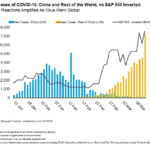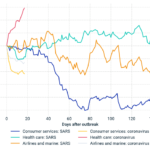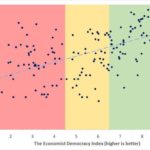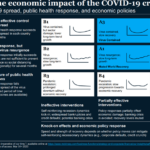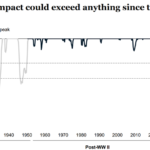Many researchers have long believed that a lab accident is the most likely source of the COVID-19 pandemic, but China has endorsed the search for animal transmission and rejected any real investigation into the possibility. In the last six weeks, however, an increasing number of scientists have openly questioned the lack of curiosity from their peers & elected officials – but new evidence has been published that provides a simple and direct answer to the world’s biggest question. It turns out that a few details didn’t make the cut when the SARS-nCoV-2 genome was sequenced in January, but on 7/15 a pair of researchers published their analysis of a Master’s thesis describing an unknown illness that killed 3 of 6 miners after they had been infected in a cave. Spoiler Alert: the simplest answer that explains the stability of the COVID-19 virus (its lack of exponential mutations that results when a virus first transitions to human hosts) is that the virus had made the jump 7 years earlier – further evolution most likely occurred at the Wuhan Institute of Virology, where China’s “Batwoman” and a team of researchers had brought samples from the cave, 800 miles to the south, to add to their collection and conduct research in 2013. Much of the debate over provenance has been framed by the speed of virus evolution, but natural mechanisms can account for the gap with or without genetic modification (see the article dated 7/14 for specifics).
The purpose of this article is to aid in the dissemination of the findings announced by Jonathan Latham, PhD and Allison Wilson, PhD; the article is the latest of a half-dozen COVID-19 pieces published since February. I have included links for all of the papers referenced/researched in order to write this article, including ones with opposing view-points (provided at the bottom of the page).
For those who are curious about my purpose or experience, I offer a short summary of my background: I spent 14 years as a Marine in the field of Chemical, Biological, Radiological, Nuclear (CBRN) defense, with 7 total years spent under the auspices of the Department of State. In the latter capacity, I led a section of Marines tasked with training, equipping and assessing the embassy security guards’ readiness against WMD threats; my tenure included the events of the Arab Spring, Benghazi, Mumbai, the rise of ISIS/ISIL/IS and the use of chemical weapons within Syria. In between stints at DOS, I spent 3 years as a Warrant Officer Instructor & Curriculum Developer for the USMC CBRN School; re-structuring the course made me intimately familiar with the Biological Weapons Convention, the National Strategy for Pandemic Influenza, and the lessons learned from the SARS, MERS and Ebola responses.
After experiencing the onset of the pandemic in Europe during a course trip to Prague (‘Business in the EU’, one of the final requirements for my MBA) I’ve spent most of the period after 3/7 researching and analyzing the progression of the crisis, and operating a non-profit website to compile unbiased information (research articles selected from the LitCovid database of the National Institutes of Health – now over 35,000+ papers) and analytics. The quality and relevance of modern journalism, already in decline, has become so partisan that even scientific developments are stripped of context and judged by how their conclusions support or weaken political objectives. I felt compelled to take on the project in March, and this article represents the most neglected, controversial and impactful facet of COVID-19 I’ve researched; the letter at the end of the article contains my thoughts from May, but any pride stemming from the potential accuracy of my early analysis is offset by the implications for post-COVID diplomacy.
The introduction from my 5/28 response to a friend’s query:
“The ultimate question posed by _______ is the same one that many researchers have been asking themselves as this crisis has continued to play out – the question of provenance. The truth is that it’s being asked because it’s a logical conclusion that explains a variety of phenomena related to the pandemic; furthermore, scientists are scared to dig too far down the rabbit hole because they fear that their own governments might be more afraid of Chinese reprisal than the truth. After all, learning that the Chinese were negligent is probably the best-case scenario.
First, it is not unprecedented for pathogens to be accidentally released from a lab that is studying them. As CBRN Marines, we were encouraged to read a book about Lab 257, a testing facility on Plum Island, just off of the northern coast of Long Island. I now find it ironic that the book was chosen as a part of our reading list, since the US government denies several of the allegations within it. Primarily, the author accuses the lab of being responsible for the source of modern global-scale Lyme disease outbreaks, the epicenter of which can be traced to a sudden cluster of cases in Old Lyme, Connecticut in 1975. The boldness of the claim belies the simplicity of the argument – that a major outbreak of a historically rare disease began there because Old Lyme sat across 7 miles of water from Plum Island; prior to 1975, cases were usually geographically distant from each other and so rare that it was difficult to diagnose since most doctors had never seen or heard of a case. Today, Lyme disease is endemic throughout the U.S. and the world.
Therefore, when COVID-19 appeared in Wuhan in late December, it was only natural for researchers to scan the surrounding environs in order to shed light on what might have sparked its emergence in Wuhan rather than somewhere else. It’s not surprising that the Chinese government leapt at the opportunity to blame the Wuhan live-market, and by some measures the connection makes sense. However, it didn’t take long for researchers from China to determine that the theory doesn’t account for all of the identified cases, including the very first (https://pubmed.ncbi.nlm.nih.gov/31986264/).”
Pandora’s Box
When I wrote that private message on May 28th, the primary focus of origin research had centered on connecting the dots for a presumed zoonotic (animal) jump or series of jumps, because direct transmission from a bat to a human would be much less likely due to the relatively weak link between bat and human cell/immune systems – as opposed to the similarity between humans and pigs (a la swine flu). Despite a broad effort, no local coronavirus strains came close to indicating a recent ancestral connection with SARS-nCoV-2, the RNA virus that causes COVID-19 infection. The prime target species, pangolins, registered a genome similarity of 93%, which in viral terms represents a huge gulf in time and evolution, whereas the Wuhan Institute of Virology had bat samples above 96.3%; this is a correlation getting stronger in the direction of direct transmission.
However, there are at least two other major issues that have vexed scientists seeking zoonotic transmission, and the first is incredibly simple yet seemingly ignored – even if a bat managed to travel 800 miles from Yunnan Province to reach Wuhan, it would have probably been hibernating at the time a transmission took place in November. The more complex issue is based on the very low incidence of mutation observed despite more than 16 million confirmed cases; this is clear evidence that COVID-19 is already well adapted to human hosts. It’s so well adapted, in fact, that it’s statistically impossible for COVID-19’s infectivity prowess to have come via gene editing, because no simulated virus has come close to matching the complexity nature has provided.
I must note that one of the primary pieces of the Latham/Wilson hypothesis is the argument that newer techniques for nudging genome changes in viruses have been developed, and the most common option simply uses human cells to force evolutionary changes to strengthen affinity for human hosts by pairing them together over and over again. This method speeds up evolution without requiring manual editing, accomplishing similar results with zero human fingerprints.
Occam’s Razor
This article is far from a complete review of the Latham/Wilson findings, much less of the other articles I’ve included, but in order to maintain the slightest pretense of brevity I must move to the alternative proposal that the pair argues can provide far more answers than a wild goose chase for pangolins and civets in southern China.
The director of the Wuhan Institute of Virology is one of the world’s leading authorities on coronavirus research; her stature grew dramatically after her team discovered the animal source of the original SARS outbreak in 2002-2003, living within certain species of bats that inhabited a cave in Yunnan Province. 10 years later, her institute had become the epicenter and repository of coronavirus research and hundreds of different strain samples gathered over several expeditions. She led her team to Yunnan once again in 2013, and among the samples gathered were the two closest relatives of the virus that caused our global pandemic. The presence of such a close cousin was bound to intensify the natural scrutiny that emerged as a result of the laboratory’s presence within the city that sparked the pandemic.
Whispers of the 2013 cave mystery have been slowly growing in intensity, as evidenced by the 7/4 story that ran in London’s Times. Detailed versions of the ‘accidental-lab-release’ theory have become more common as well, but the 7/15 article by Latham/Wilson has provided additional evidence and the most plausible explanation by far. It’s persuasive enough that I’ve decided to publicly comment, so that their article (and 12 other related items) can begin to reach a broader audience.
Why does my CBRN/Marine/Historian/Analytics intuition find this proposal so plausible? The best answer is that China has meticulously ignored, obfuscated, erased or ‘forgotten’ many of the details within the timeline laid out by Latham and Wilson:
- The original stated purpose of the 2013 expedition was to investigate a “fungal” infection, but Dr. Zhengli Shi (“Batwoman”) personally led the sampling team; as a renowned expert on coronaviruses, there would have been no reason for her and a team of virus researchers from the WIV to travel there.
- The Chinese have also avoided referencing the 2013 miner incident despite its obvious resemblance to COVID-19 symptoms. That’s probably because most people don’t know that the RaTG13 strain (the closest relative of COVID-19) was taken during the aforementioned trip, which was undertaken specifically to investigate the earlier outbreak. RaTG13 is the strain that shared a very high affinity for the ACE2 receptor (like COVID-19), but didn’t compare as well with the original SARS-CoV from 2003.
- If not for the discovery of a master’s thesis that linked the WIV to the 2013 mystery illness investigation, we might have never known the full story behind the acquisition RaTG13 and other samples by the WIV.
- Shi partnered in publishing results of experiments involving “gain of function” by exposing coronaviruses to human, monkey and mouse cells to encourage adaptive evolution to make the affinity even greater. Her papers are readily available online.
- Many of the detractors arguing against an accidental lab release have pointed to the time needed to produce evolutionary changes that could account for the 3.7% gap between the genomes of RaTG13 & SARS-nCoV-2, estimated at 20-50 years. There is broad agreement that the genome doesn’t seem to have artificial insertions, but RaTG13 was an obvious candidate for gain-of-function experiments, and the methods used could explain the exponential condensing of evolutionary progress & the absence of evidence of human gene modification.
- In late May, China announced that the evidence no longer supported the claim that the Wuhan Live Market was the location where zoonotic transmission to humans took place.
Actions speak louder than words, especially when China isn’t saying much to begin with. Even the publication of the full gene sequence in early January was unplanned; Shi’s team had completed the task more than a week before the milestone was announced, but an unauthorized release from another research group forced the hand of the WIV. Not until January 23rd did the WIV release the full sequence of RaTG13, a virus it had held for seven years. And, ignoring the 2013 outbreak leads to greater attention being given to the search for an intermediate species; why would scientists want to focus on a less attractive theory, when the possibility exists that the first emergence of human COVID was in 2012, not 2019?
Latham and Wilson’s article (https://www.independentsciencenews.org/commentaries/a-proposed-origin-for-sars-cov-2-and-the-covid-19-pandemic/) deserves greater attention, so why haven’t more media outlets investigated the most plausible analysis of the pandemic’s genesis? China’s intransigence is unusual, because many possible outcomes could help exonerate the country from suspicions regarding the origin of the pandemic.
The alternative is that China’s silence is a natural result of being stuck in a corner, unable to offer any evidence that could clear their name because none exists. The reluctance to consider a lab accident has raised eyebrows in Europe and Australia, and the theory represents the application of Occam’s Razor to the mystery of COVID-19’s birth?
The Razor principle has highlighted a possible solution that demands a thorough investigation. Continued Chinese resistance would further imply that their unwillingness to help discover Pandora’s opened Box stems from the fear that investigators might find their fingerprints on the lid.
—C. H. Rixey
(c) rixanalytics.com, 2020
References
5/21 https://doi.org/10.1101/2020.05.21.108506
No Evidence for increased transmissibility from recurrent mutations in SARS-CoV-2
Van Dorp et al – pending review/BioRxiv
6/4* https://project-evidence.github.io/
6/4 https://www.cell.com/cell/pdf/S0092-8674(20)30820-5.pdf
Tracking Changes in the SARS-Cov-2 Spike: Evidence that D614G Increases Infectivity of the COVID-19 Virus
7/4 https://www.thetimes.co.uk/article/seven-year-covid-trail-revealed-l5vxt7jqp
7/23 https://time.com/5870481/coronavirus-origins/
My full private response of 5/28, written to a group of experienced & interested peers:
“The ultimate question posed by _______ is the same one that many researchers have been asking themselves as this crisis has continued to play out – the question of provenance. The truth is that it’s being asked because it’s a logical conclusion that explains a variety of phenomena related to the pandemic; furthermore, scientists are scared to dig too far down the rabbit hole because they fear that their own governments might be more afraid of Chinese reprisal than the truth. After all, learning that the Chinese were negligent is probably the best-case scenario.
First, it is not unprecedented for pathogens to be accidentally released from a lab that is studying them. As CBRN Marines, we were encouraged to read a book about Lab 257, a testing facility on Plum Island, just off of the northern coast of Long Island. I now find it ironic that the book was chosen as a part of our reading list, since the US government denies several of the allegations within it. Primarily, the author accuses the lab of being responsible for the source of modern global-scale Lyme disease outbreaks, the epicenter of which can be traced to a sudden cluster of cases in Old Lyme, Connecticut in 1975. The boldness of the claim belies the simplicity of the argument – that a major outbreak of a historically rare disease began there because Old Lyme sat across 7 miles of water from Plum Island; prior to 1975, cases were usually geographically distant from each other and so rare that it was difficult to diagnose since most doctors had never seen or heard of a case. Today, Lyme disease is endemic throughout the U.S. and the world.
Therefore, when COVID-19 appeared in Wuhan in late December, it was only natural for researchers to scan the surrounding environs in order to shed light on what might have sparked its emergence in Wuhan rather than somewhere else. It’s not surprising that the Chinese government leapt at the opportunity to blame the Wuhan live-market, and by some measures the connection makes sense. However, it didn’t take long for researchers from China to determine that the theory doesn’t account for all of the identified cases, including the very first (https://pubmed.ncbi.nlm.nih.gov/31986264/).
Four months later, the official position of China continues to be that COVID-19 jumped from animal to human within the live market, despite the lack of any bats available for sale there. Furthermore, there wasn’t an expected genetic marker from a intermediary species, something which could’ve substantiated that direction of investigation; instead, the evidence showed that human-to-human transmission was occurring prior to contamination in the market.
Based on that premise, the real question is figuring out where the first human case came from, but as the virus began to spread outside of mainland China the ruling party severely restricted publication or research of any information regarding the origin of the virus, and all articles are now subject to pre-approval from a government censor before they can be released.
As it stands, I don’t lean in the direction of an intentional release, because that would run counter to the regime’s long-standing goals in the region and globally. Instead, it seems far more likely that our current pandemic is the result of an ‘oops’ similar to Plum Island in 1975 – an accidental release of something actively being researched. It’s disturbingly easy to imagine that some unnamed scientist, operating within China’s brand-new (and only) BSL-4 laboratory, within mere miles of the Wuhan live market, somehow brought the virus home one night. The real story is what is spreading, not how it started.
Scientists have concluded that the current coronavirus is in fact a slightly mutated form of a strain first discovered in 2013, announced in this article from Nature: https://www.nature.com/articles/nature12711. This connection was acknowledged on the Netflix special episode regarding the COVID-19 crisis, ultimately meant to be part of a series. Researchers had been mining betacoronaviruses in bats in China ever since SARS highlighted the danger 18 years ago, and that 2013 strain in particular was notable for its receptors capable of binding to a human’s ACE2 cell proteins with high affinity, needing only a nudge to do so. Ultimately, the strain was ignored because its other features didn’t indicate potential for a near-term threat, but within two years China had successfully advocated for (and received approval) the right to build a BSL-4 laboratory. On one hand, I would’ve seen those developments as a positive, since it would mean greater collaboration and oversight amongst the scientific community, especially for a country that is certainly suspected of harboring an active biological weapons program. The ultimate result, however, is that the 2013 species came to be stored in one of the world’s largest cities, to be studied along with other coronaviruses and various samples of other high-threat pathogens.
I have no doubts that the virus originated from one of the two Wuhan laboratories, but it’s very difficult to ever determine if the genome was tweaked without access to them, and I don’t think there’s any evidence left to find (or people to testify, for that matter). I can assure you that there is zero interest amongst the members of the House Intelligence Panel to investigate anything prior to the November election, as that would run counter to their preferred narrative of Trump’s failure with COVID-19.
There’s been a lot of conjecture about vaccines, Bill Gates, etc., but I don’t see the need for any impetus beyond China’s desire to gain competitive advantage. I don’t think they had to work to tweak the genome, since the mere combining of various and humans within a research facility increased the likelihood of the jump being made – and a researcher who accidentally exposed himself would’ve been desperate to hide that knowledge from his authoritarian government.
The odds of the virus emerging from somewhere else are so small compared with the likelihood of escaping from one of the Wuhan labs that it only makes sense for China to have cut off all information leading down that pathway.”



